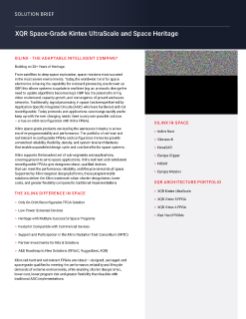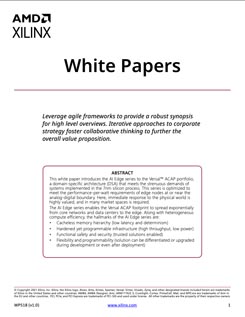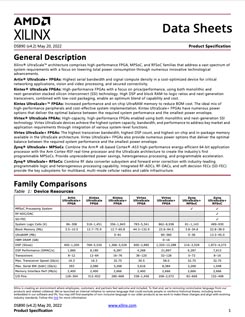- 器件
- FPGA 和 3D IC
- Space-Grade Kintex UltraScale FPGA Family
RT Kintex UltraScale FPGA
For Ultra High Throughput and
High Bandwidth Applications
Radiation Tolerant Kintex UltraScale Product Overview
XQR Kintex™ UltraScale FPGAs are high-performance monolithic FPGAs with a focus on performance. High DSP and block RAM-to-logic ratios and next-generation transceivers combined with space-grade packaging to handle vibration and handling requirements for launch and operation enable a new generation of high-density FPGAs for on-orbit reconfiguration targeted for applications like on-board processing, digital payloads, remote sensing, and many more.
Applications
Key advantages of RT Kintex UltraScale:
- True Unlimited On-Orbit Reconfigurable Solution
- >10X DSP Compute increase for Processing Intensive Algorithms & Analytics
- Full Radiation Tolerance across All Orbits
- Machine Learning Ecosystem enables High Performance Edge Inference in Space
- Vivado & Vitis Support
- Prototyping available NOW!

Product Table
| Virtex 4QV (90nm) XQRV4QV |
Virtex 5QV (65nm) XQRV5QV |
RT Kintex UltraScale (20nm) XQRKU060 |
|
|---|---|---|---|
| Radiation Hardness | Tolerant | Hard | Tolerant |
| Memory (Mb) | 4.1 to 9.9 | 12.3 | 38 |
| System Logic Cells (k) | 55 to 200 | 131 | 726 |
| CLB Flip-Flops (k) | 49.1 to 178.1 | 81.9 | 663 |
| CLB LUTs (k) | 49.1 to 178.1 | 81.9 | 331 |
| MGTs | None | 18 at 4.25Gbps | 32 at 12.5 Gbps |
| User I/O | 640 to 960 | 836 | 620 |
| DSP Slices | 32 to 192 | 320 | 2,760 |
| Radiation (TID, SEL) | 300, >125 | 1,000, >125 | 100, >80 |
| Reliability (Package, Test) | CNA1509; V-Flow | CNA 1752; B-Flow & V-Flow | CNA 1509; B-Flow & Y-Flow |
Documentation
RT Kintex UltraScale Radiation Characteristics
The space-grade XQR UltraScale™ architecture-based devices extend the benefit of commercial silicon with unique ceramic column grid array package, tested to stringent qualification flows like AMD B, Y test flows (QML compliant), full military operating temperature range support, and radiation tested for single-event effects. RT Kintex UltraScale device uses more than 40 proprietary, patented circuit design and layout techniques to reduce the SEU cross-section. The table below lists radiation characteristics for RT Kintex UltraScale.
| Symbol | Description | Min | Typ | Max | Units |
|---|---|---|---|---|---|
| TID | Total Ionized Dose (GEO) | - | 100 | 120 | Krad (Si) |
| SEL | Single-Event-Latch-Up Immunity | - | 80 | - | MeV-cm2/mg |
| SEUCRAM | Single-Event Upset in Configuration RAM (GEO) | - | 1.0e-8 | - | Upset/bit/day |
| SEUBRAM | Single-Event Upset in Block RAM (GEO) | - | 8.5e-9 | - | Upset/bit/day |
| SEFICRAM | Single Event Functional Interrupt Orbital Upset Frequency – Configuration RAM (GEO) | - | 4.5e-4 | - | Upset/device/day |
The following table describes the types of Single Event Effects. For detailed reports visit the Space Lounge.
| Radiation Type | Radiation Signature | Target/Comments |
|---|---|---|
| Single Event Upset (SEU) | Corruption of the information stored in a memory element | Memories, latches in logic devices. Composed of single bit upsets (SBU) or multiple bit upset (MBU). |
| Single Event Transient (SET) | Impulse response of certain amplitude and duration | Analog and mixed-signal circuits. Can lead to SEU if latched in memory cell. |
| Single Event Latchup (SEL) | High-current conditions | CMOS devices. Might lead to hard failure. |
| Single Event Functional Interrupt (SEFI) | Corruption of a datapath leading to loss of normal operation | Complex devices with built-in state machine/control sections or systems. |


